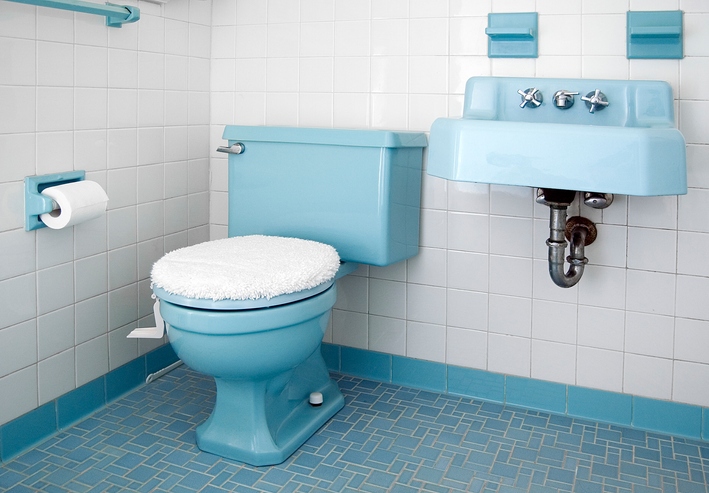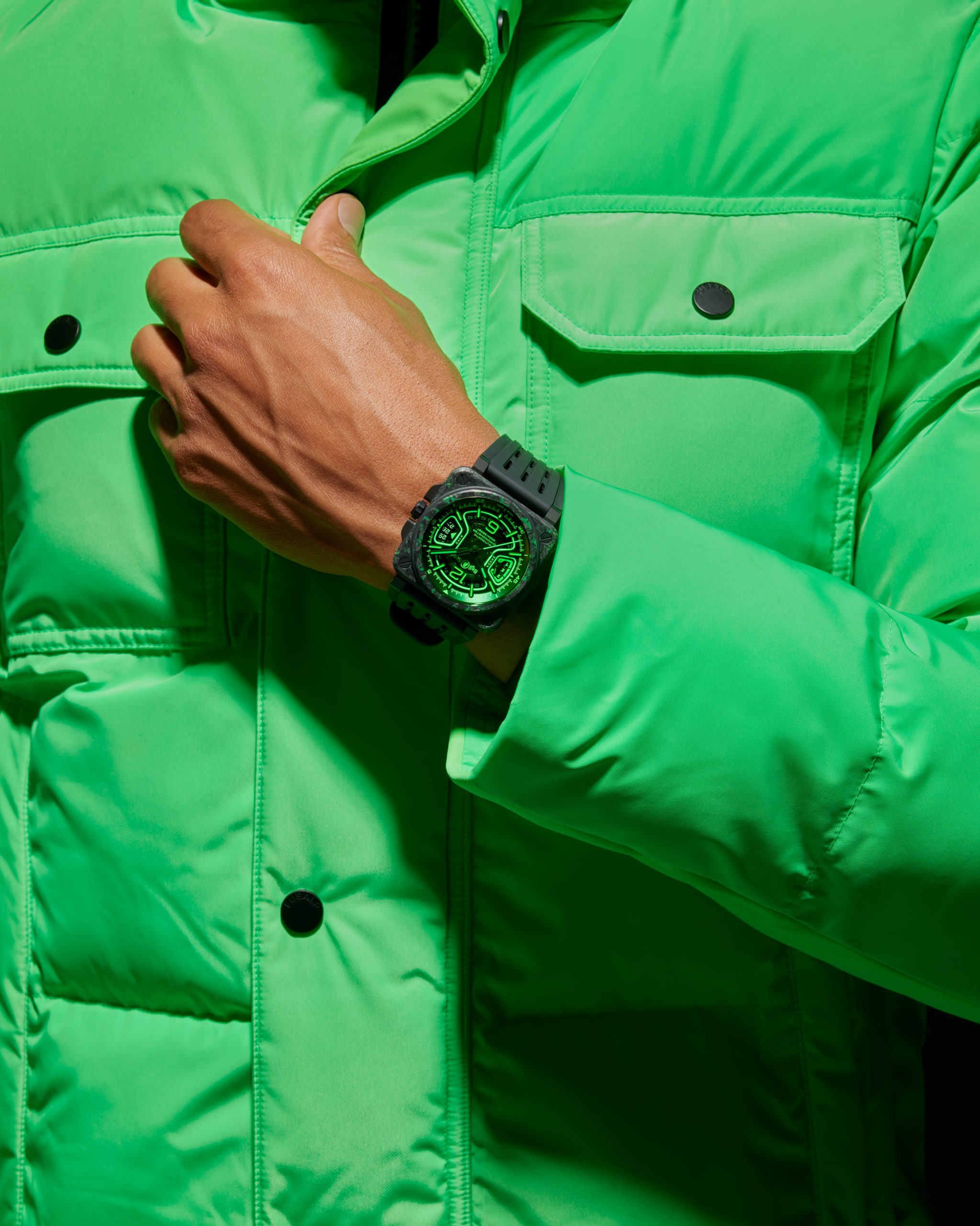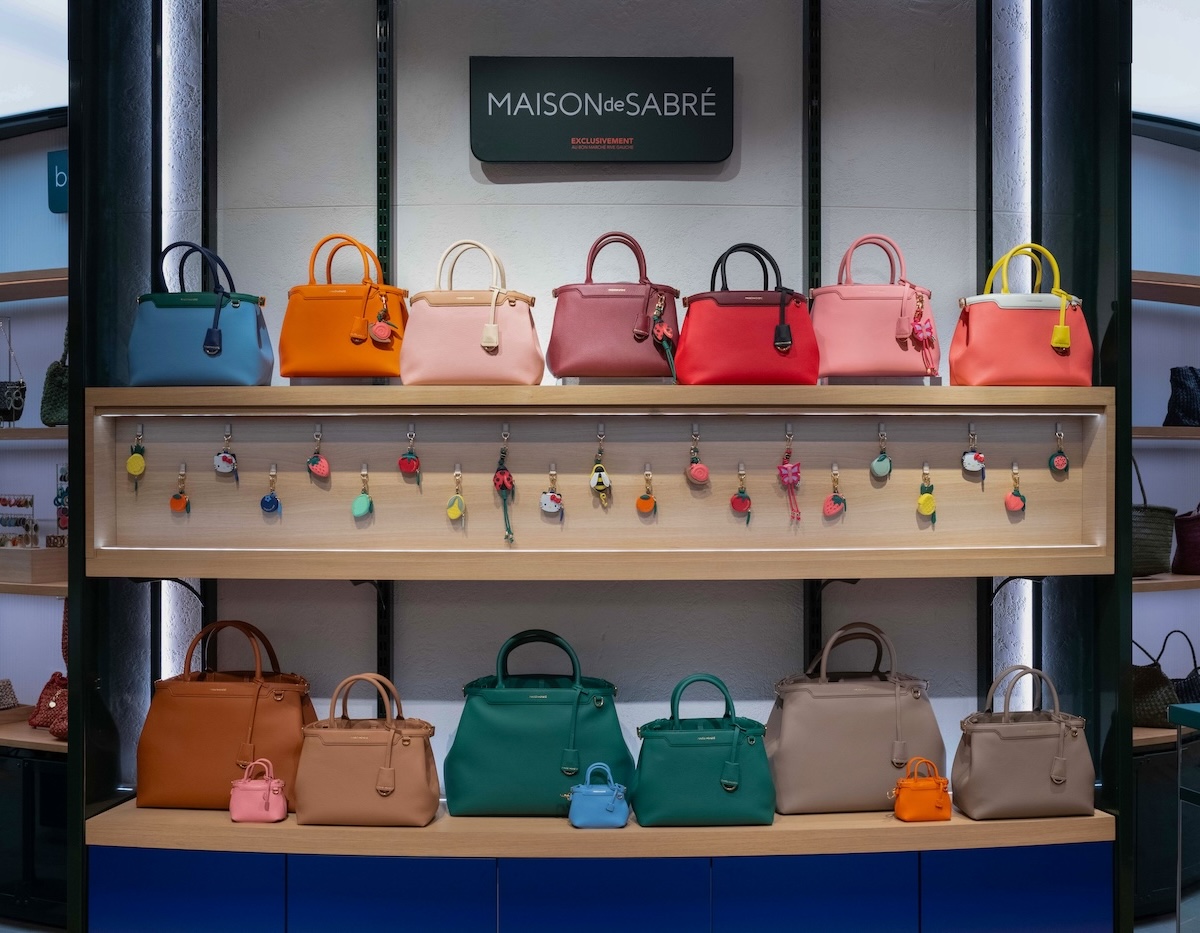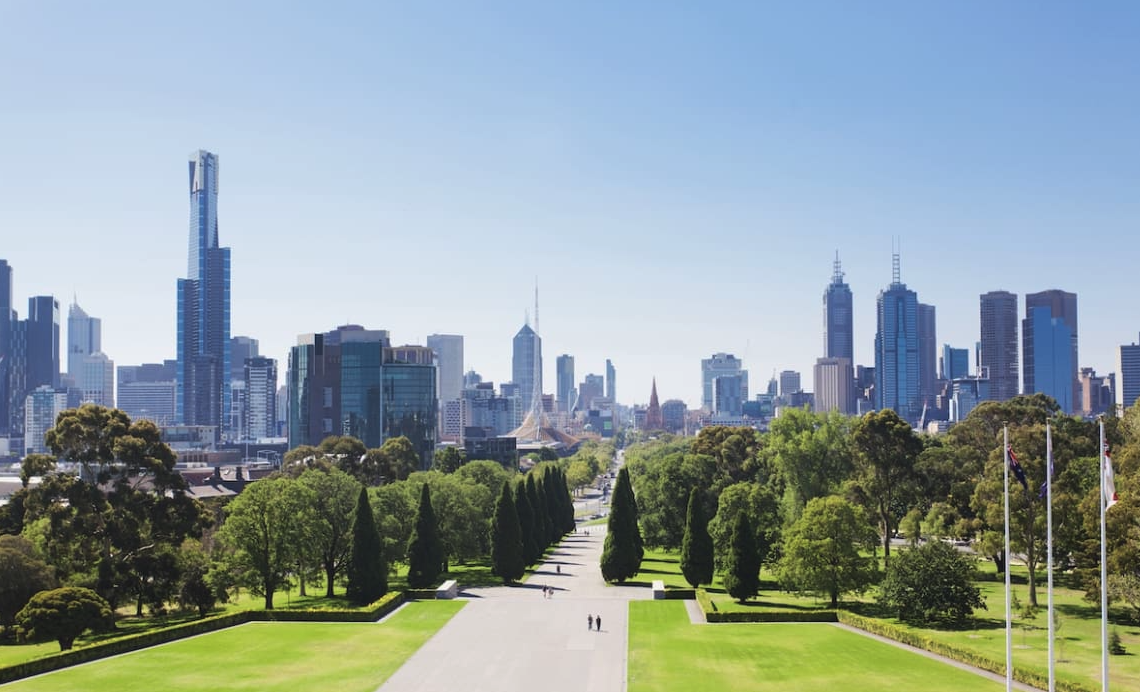Baby Blue Tubs and Lemony Loos. Are Coloured Bathroom Fixtures Chic Again?
The divisive trend has design pros in a lather. Here, they argue both sides.
COLOURED TUBS and sinks are getting another shot. Design experts are revisiting the look, which originated in the 1920s. American waterworks brand Kohler recently revived two heritage colors they originally released in the ’20s and ’30s, and British manufacturers such as the Water Monopoly and the Bold Bathroom Company have found fans on both sides of the Atlantic.
Some designers, however, wincingly recall the avocado-hued tubs and sinks of the 1970s and hold that coloured fixtures are a trend that will date very quickly. For these naysayers, only white bath fixtures will do. Here, they debate the issue.
Yes, coloured fixtures give a bathroom a much-needed shot of style.
Many design pros applauded the news that come summer, Kohler’s bathroom fixtures—including toilets—will be available in two shades from its archive: Spring Green, an icy teal, and Peachblow, a mauvy pink. Fans of the chromatically diverse Rockwell collection from the Water Monopoly, meanwhile, appreciate the fixtures’ vaguely vintage eccentricity.
London interior designer Lizzie Green nestled a Powder blue Rockwell tub, one with a puffy upper rim and spheres for feet, against a wall of variegated green-blue tiles (above). “The playful design creates a center piece in a large bathroom,” she said. (In a similarly bold move, Ms. Green installed a blue art deco pedestal sink from British manufacturer the Bold Bathroom Company in a shower room clad in rose-pink tile.)
Elizabeth Metcalfe, of EM Design in Toronto, made a chalky green Rockwell tub the hero of a primary bath and a foil to some serious luxury. It sits amid walls of Breccia marble—a creamy stone veined in deep purple—and windows hung with pink cashmere drapery. The tub gives an otherwise conservative, grown-up room a “uniquely stylish” edge, she said.
The designers we surveyed agree that the trend’s biggest fans are older millennials who grew up in what Lauren Lothrop Caron terms the “beige 2000s.” The founder of Seattle’s Studio Laloc—a senior millennial herself—urges her contemporaries to be bold. For her own bathroom remodel, she’s eyeing Kohler’s Peachblow fixtures.
Noncommittal types might do best to choose one small colored fixture, says Jake Rodehuth-Harrison, founder of Los Angeles design firm Hubbahubba. Mr. Rodehuth-Harrison loves the “heavy dose of nostalgia” the pieces provide at a time when “the design world and algorithms are always looking forward and saying new, newer, newest.” He popped lilac ball feet onto another Water Monopoly Rockwell tub, this one white, in a Napa Valley, Calif., project. The result perches, most surprisingly, on muted green flooring he chose. If that’s too bold, “we can neutralize these fixtures by surrounding them with tiles in the same color,” he noted.
Another trick: Tiffany Duggan of London’s Studio Duggan suggests working with vintage fixtures that were born white. The designer recently updated an original iron tub with a wash of Farrow & Ball’s Red Earth. “If you change your mind, you can just paint over it.”
No, colored basins and bathtubs are too fatally trendy and impractical besides.
Doubters say hued baths will be a blip on the trend continuum. Unless you’re trying to preserve the aesthetic of a historic home, warned Liana Hawes Young, creative director of Wimberly Interiors in New York City, “colored fixtures will feel dated quickly, if not immediately.” And unlike trendily tinted shower curtains or wall paint that can be changed with little expense, this craze requires a spendy swap out, argued naysayers. Said Kristina Phillips, an interior designer in Ridgewood, N.J., “Clients looking for more long-term, classic design, along with keeping eventual resale in mind, might hesitate.”
Traditionalists say that if you really must, relegate such vivid choices to powder rooms and kids’ baths, spaces you don’t linger in. And well-intentioned salvage-scourers should be wary of mixing eras, said other concerned parties. “Vintage plumbing fixtures can date a space due to their scale,” explained Hattie Collins, founder of Hattie Sparks Interiors, in New Orleans. “Most times, coloured tubs and toilets are much smaller than present-day fixtures.” A safer bet, she suggests, is to focus on rescuing original floor and surround tile.
Powder blue is one thing, many say, but bright or hot-hued renditions of this trend read garish. “Neons and oranges could be a thorn in the room,” said Los Angeles designer Gilda Hariri. Even Ms. Metcalfe, who otherwise champions the trend, warned, “Avoid vibrant, aggressive tones, such as reds and oranges, that evoke a strong emotional response.”
Designers who actually can see a place for coloured fixtures couldn’t help but trivialise the trend as “retro” and “eclectic.” The rest of the room has to quietly suggest luxury, they suggest, to balance kookiness with class. Ms. Collins thinks wallpaper that has layered, expressive colours—the sort often offered by House of Hackney, Gracie or Cole and Son—could help coloured fixtures read higher end, as would lighting of reeded glass and high-quality metal finishes. “Lovely but expensive,” she added. Is the cost of a cheerful toilet really worth it?
The power of association doesn’t work well in the trend’s favor, either. A black bathroom, for instance, installed for a sense of refined moodiness, might evoke one from a 1980s basement nightclub, giving words like sterility and sanitary a new appeal. Austere white bathrooms, a holdover from the “hospital white’” tiled bathrooms of the early 1920s, are far more practical. Dark colours reveal water marks and chalky toothpaste smears. To Kristine Renee, co-founder of Sacramento, Calif., interiors firm Design Alchemy, “Nothing ever seems as clean as white.”
The Wall Street Journal is not compensated by retailers listed in its articles as outlets for products. Listed retailers frequently are not the sole retail outlets.
 Copyright 2020, Dow Jones & Company, Inc. All Rights Reserved Worldwide. LEARN MORE
Copyright 2020, Dow Jones & Company, Inc. All Rights Reserved Worldwide. LEARN MORE
Pure Amazon has begun journeys deep into Peru’s Pacaya-Samiria National Reserve, combining contemporary design, Indigenous craftsmanship and intimate wildlife encounters in one of the richest ecosystems on Earth.
Australia’s housing market defies forecasts as prices surge past pandemic-era benchmarks.
Pure Amazon has begun journeys deep into Peru’s Pacaya-Samiria National Reserve, combining contemporary design, Indigenous craftsmanship and intimate wildlife encounters in one of the richest ecosystems on Earth.
Pure Amazon, an A&K Sanctuary, has officially launched its voyages into the 21,000-square-kilometre Pacaya-Samiria National Reserve.
Designed for just 22 guests, the new vessel positions itself at the high end of wilderness travel, offering quiet, immersive, and attentive experiences with a one-to-one staff-to-guest ratio. The focus is on proximity to wildlife and landscape, without the crowds that have made parts of the Amazon feel like tourism has arrived before the welcome mat.
Where Architecture Meets the River
The design direction comes from Milan-based architect Adriana Granato, who has reimagined the boat’s interiors as part gallery, part observatory. Floor-to-ceiling windows frame rainforest scenes that shift hour to hour, and every space holds commissioned artworks by Peruvian artists.
The dining room’s centrepiece, Manto de Escamas de Paiche by Silvana Pestana, uses bronze and clay formations that mirror the scale patterns of the Amazon’s giant fish. Pestana’s works throughout the vessel reference environmental fragility, especially the scars left by illegal gold mining.
In each suite, hand-painted kené textiles by Shipibo-Konibo master artist Deysi Ramírez depict sacred geometry in natural dyes. Cushions by the BENEAI Collective feature 20 unique embroidered compositions, supporting Indigenous women artists and keeping traditional techniques alive in a meaningful, non-performative way.
Wildlife Without the Tame Script
Days on board are structured around early and late river expeditions led by naturalist guides. Guests may encounter pink river dolphins cutting through morning mist, three-toed sloths moving like they’re part of the slow cinema movement, and black caimans appearing at night like something from your childhood nightmares.
The prehistoric hoatzin appears along riverbanks, giant river otters hunt in packs, and scarlet macaws behave like the sky belongs to them. The arapaima — the same fish inspiring Pestana’s artwork — occasionally surfaces like an apparition.

A Regional Culinary Lens
The culinary program is led by a team from Iquitos with deep knowledge of Amazonian produce.
Nightly five-course tasting menus lean into local ingredients rather than performing them. Expect dishes like caramelised plantain with river prawns, hearts of palm with passionfruit, and Peruvian chocolate paired with fruits that would be unpronounceable if you encountered them in a supermarket aisle.
A pisco-led bar menu incorporates regional botanicals, including coca leaf and dragon’s blood resin.
A Model of Conservation-First Tourism
Pure Amazon’s conservation approach goes beyond the familiar “offset and walk away” playbook. Through A&K Philanthropy, the vessel’s operations support Indigenous community-led economic initiatives, including sustainable fibre harvesting and honey production in partnership with Amanatari.
Guests also visit FORMABIAP, a bilingual teacher training program supporting cultural and language preservation across several Indigenous communities. Notably, the program enables young women to continue their education while remaining with their families — a rarity in remote regions.
Low-intensity lighting, heat pump technology, and automated systems reduce disturbance to the reserve’s nocturnal wildlife.

The Experience Itself
Itineraries span three, four, or seven nights. Mornings often begin with quiet exploration along mirrorlike tributaries; afternoons allow for spa treatments or time on the open-air deck. Evenings shift into long dinners and soft-lit river watching as the rainforest begins its nightly soundtrack.
Granato describes the vessel as “a mysterious presence on the water,” its light calibrated to resemble fire glow rather than a foreign object imposing itself on the dark.
It is, in other words, slow travel done with precision.
Records keep falling in 2025 as harbourfront, beachfront and blue-chip estates crowd the top of the market.
Australia’s market is on the move again, and not always where you’d expect. We’ve found the surprise suburbs where prices are climbing fastest.























